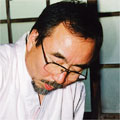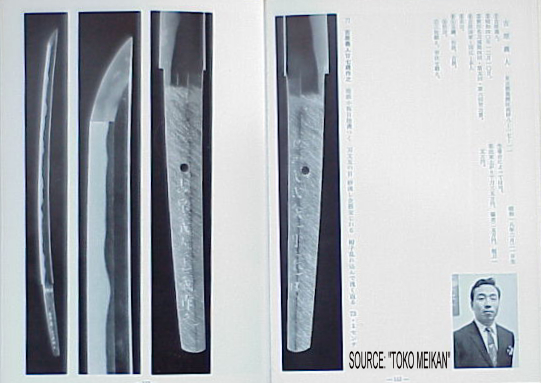Gallery Page (Display Only)
Fine Moroha (double edged) Style Tanto
by
Yoshindo Yoshihara
Rated Mukansa – “without judgement”
The Hada is Itame, Hamon is Togari-Gunome – Bizen style. The measurements are cutting edge length (Nagasa) 9 7/8″ or 25.1 cm, Motohaba (width) is 1 3/16″ or 3 cm and no Sori.
Presentation Box
Read on below for more details on Yoshindo Yoshihara
Yoshindo

Born: 1943
Awards: Mukansa (1982)
The Prince Takamatsu Award (3)
Award by Director-General of the Agency for Cultural Affairs (2)
NBTHK Honorary Chairman Award
Kuzan Award (1)
Award for Excellence (3)
Award for Effort (4)
“Yoshindo”, descends from a distinguished line (mon) of “Nihon To Kaji” (Japanese Sword makers). He was exposed to the art of sword making since childhood. He began studying sword making at the age of “12”, under the Tudor ship of his Grandfather, who founded the “Yoshihara Mon (School).”
Yoshindo, is perhaps the most famous sword maker of our time. Through painstaking experimentation, and methodical persistence he has not only “rediscovered” many of the “lost secrets” of the Kamakura period of art sword making, but improved some of them. One of his first major accomplishments was the successful recreation of “Utsuri” (like viewing the reflection of the tempering pattern, in the waters of a tranquil pond). The creation of the ancient style of “Utsuri” has eluded all but a very few of the finest swordsmiths for hundreds of years!
Yoshihara Yoshindo 吉原義人
He received his official sword making license in 1965. At the National sword making contest, he proceeded to win, five third place prices, two second place prices, and “7” first place prices! In 1982, he was awarded the prestigious title of “Mukansa” (Above and beyond entering sword making competitions). In 1973 Yoshindo was the first-ever winner of the Prince Takamatsu Award at the annual Modern Swordsmiths Exhibition (Shinsakumeitoten). As a result One of his award winning blades underwent a cutting test, done by “Terutaka Kawabata”, a famous sword tester. It successfully cut a finely made iron kabuto (helmet) that was over 2″ ~ 5 cm deep, it was truly amazing with no damage to the sword. The Prince had wanted to ensure that modern swords would excel functionally as well as aesthetically before giving the award. Once the test had been completed, the Prince (convinced of their cutting ability) never requested a cutting test again. Yoshindo went on to win the Takamatsu Award on a further two occasions. He made and presented King Carl Gustaf XVI of Sweden with a tanto. The King (a sword enthusiast) visited Yoshindo’s forge and workshop, as well as the N.B.T.H.K.. Yoshindo co-authored the book, The craft of the Japanese Sword” with Leon Kapp. He was made an honorary citizen of Dallas Texas, where he held a private exhibition, in 1980. He exhibited for the Boston Metropolitan museum of art, in 1981, the Marine University of California in 1982 and the San Francisco airport gallery in 1983. In 1989 he exhibited a tanto that was made from a meteorite, at the Takashimaya a department store. Yoshindo possesses superb skill, a remarkable artistic eye and vast knowledge of metallurgy and science. On two occasions he received requests for his swords from Japan’s premier shrine, Ise Jingu. The swords were made with full ceremony of Shinto ritualism and are considered ‘sacred swords’.
Yoshindo’s sensei (teacher) was his grandfather “Kuniie (Katsuyoshi) Yoshihara”, who was born in Iwaraki prefecture in 1894, later he moved to Tokyo as a young man and became the student of “Shigetsugu Kasama” and “Akihide (Hikosaboro) Kunihara, he was considered to be one of their finest students. His works are mainly done in the Koto style. During WW II, he trained swordsmiths for the Army, a position of great honor. He passed away in Showa 45 at the age of 76.
The father of Yoshindo is, “Kuniie Masahiro”, a well known sword maker. His older brother is the famous “Kuniie Shoji” who carries his grandfathers name. He is an extremely accomplished swordsmith. He also holds the coveted title of “Mukansa” (above entering any contest). He has made major contributions to the art of sword making. I have seen a blade by him, done in the Kamakura Bizen style. The hada (blade grain structure), and choji hamon (tempering), are marvelous.
In 1998 Yoshindo and Shoji were made intangible cultural properties of the ward in which they live, Tokyo’s Katsushika ward. In March, 2004, Yoshindo was elevated to the level of Tokyo no mukei bunkazai, or intangible cultural property of Tokyo. He received his award with due ceremony at the civic centre in Tokyo. He has made blades for several national institutions and exhibited at many venues in Japan. Yoshindo has also been a great ambassador for swordmaking outside of Japan. He has given extended demonstrations of forging and lectures all over America, exhibited at several private galleries and has had swords displayed in The New York Metropolitan and Boston Museums. Yoshindo has also built forges in Dallas and San Francisco in an effort to further understanding of the Japanese sword in the west. He travels regularly to the United States to support Japanese sword events and attend knife shows. Yoshindo continues to head the Yoshihara family of smiths from the Nihonto Tanren Dojo, where he currently has three apprentices in training.
The Nihonto Tanren Dojo
On June 16, 1971, in honor of their grandfather, Yoshindo and Shoji opened the Nihonto Tanren Dojo; a swordsmith workshop on the grounds very close to where their grandfather’s workshop had been in Katsushika-ku, Tokyo. At this time the Japanese economy had been recovering from its post-war depression, interest in swords had regained its popularity, and collectors were once again able to afford such luxuries. However, making a living as a swordsmith was still a tough route to take. In spite of this, Yoshindo and Shoji closed the crowbar business and took their chances as full-time swordsmiths.
The Nihonto Tanren Dojo was opened with full ceremony and attended by the most influential scholars of the Japanese sword world. Dr Sato Kanzan and Homma Kunzan, the directors of the NBTHK, were the principle guests, along with Honami Kohaku, whose family had been appraising swords since the 15th century. Also in attendance was a young Nobuo Ogasawara, a future great scholar and senior curator of Japanese swords at Tokyo National Museum. Inside the dojo there is a plaque hanging on the wall. It is handwritten and signed in the calligraphy of Dr. Sato Kanzan. It reads ‘Kote nasu hyaku ren tetsu’ (with a hundred times forging, comes good steel). Yoshindo has had many visitors to the workshop, including a one-time visit by Sweden’s monarch King Carl XVI Gustaf. The Yoshihara brothers originally shared this forge, but Shoji currently has his own forge at his residence in Nishi Mizumoto.
This Sword is not available for purchase.
If you wish to purchase a Japanese Sword please view our Nihonto for sale page or contact us directly via email or contact us at 1(608) 315-0083 any time, please include specifics of what you seek, i.e.: Katana, maker, era, price range etc.
Pictures and content may not be copied without the express permission of samuraisword.com ©
















